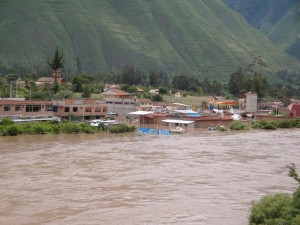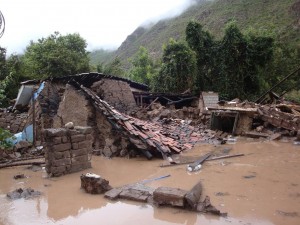
During the recent extreme flooding in Peru, media attention centred almost wholly and shamefully on the 1,300 tourists stranded at Machu Picchu.
Now that they have been airlifted out from their luxury hotels – one told the television cameras that the helicopter ride ‘made his holiday’ – it is worth considering the real impact of the flooding on the people who actually live there.
For the episode is just a waymark in a far more important story. The Andes is being ripped apart by a series of recent climatic disasters that threaten to destroy the fragile peace established since the terrible period of the Sendero Luminoso when Maoist revolutionaries held Peru to ransom in the 1990s.
This has always been one of the most volatile parts of the world meteorologically, as discussed in my post on the Moche below (‘Every six or seven years , a change in Pacific wind-directions causes a build up of much warmer water along Peru’s coast: initially it is the fishing which suffers; then the whole climate gets thrown into reverse, with flooding in the deserts and drought in the mountains’).
But with global warming, what was an occasional El Niño phenomenon looks set to become far more regular – and even more extreme. The Andean micro-climate means that the Quechua Indians in the hill, of whom there some 25 million, are beginning to experience ‘reverse global warming’ in the form of much colder, wetter winters.
Enduring prolonged sub-zero temperatures is a matter of course for Peru’s indigenous mountain people, many of whom live at more than 3,000m above sea level. Scores die every year from the cold, but in recent years the number of people succumbing to the freezing temperatures has triggered talk of a national crisis.
I have led many research expeditions to the high Andes and have an endless respect for the toughness of Quechua-speaking farmers and their families, who have managed to subsist for centuries at high altitude. They are the only mountain people I have seen in the world who still plough their highest fields by hand – even in the poorest bits of the Himalaya, they have beasts of burden to help them. But now some of them believe that they may not make it through the next southern winter.
The changing weather has affected both livestock and the potato harvest, and is compounded by resulting problems in water supply and sanitation; children’s health has got much worse (particularly acute bronchial problems) and food production has fallen by over 40%.

All this means that Peru may be ripe for conflict again, because the neglected, mostly native Andeans resent the coastal-based, more European government – just as many have emailed me to complain that all the West seems to care about is the comfort of a handful of tourists marooned in luxury hotels. And if they do rise up, as the carnage of the Sendero Luminoso showed, the consequences both for the country and the continent will be extreme.
Over the last decade or so, we’ve got used to a more stable and democratic Latin America, but that, like the climate, could easily go into reverse.

In 2004, my wife and I made the journey by train from Cusco to Agua Calientes and then on to Machu Picchu. There had been some recent rock falls, just cleared, and a week or so after we returned, there was more significant rainfall leading to flooding, the closure of the railway and the stranding of tourists, for some weeks. I must admit our thoughts went firstly to the tourists as we wondered how their onward travel plans would be affected. We had no doubt they would be well looked after in their hotels, at least until the food ran out !
Your article puts a completely different, wider perspective on the issues. We saw the main issue then as the damage to the tourist trade and the irretrievable loss of income of the residents in Aguas Calientes if the rail link could not be restored. I have to admit we did not consider the wider issues of the damage to the Andean way of life across the high Andes caused by the flooding and your article reveals some hitherto unappreciated aspects of climate change in that region.
Thank you.